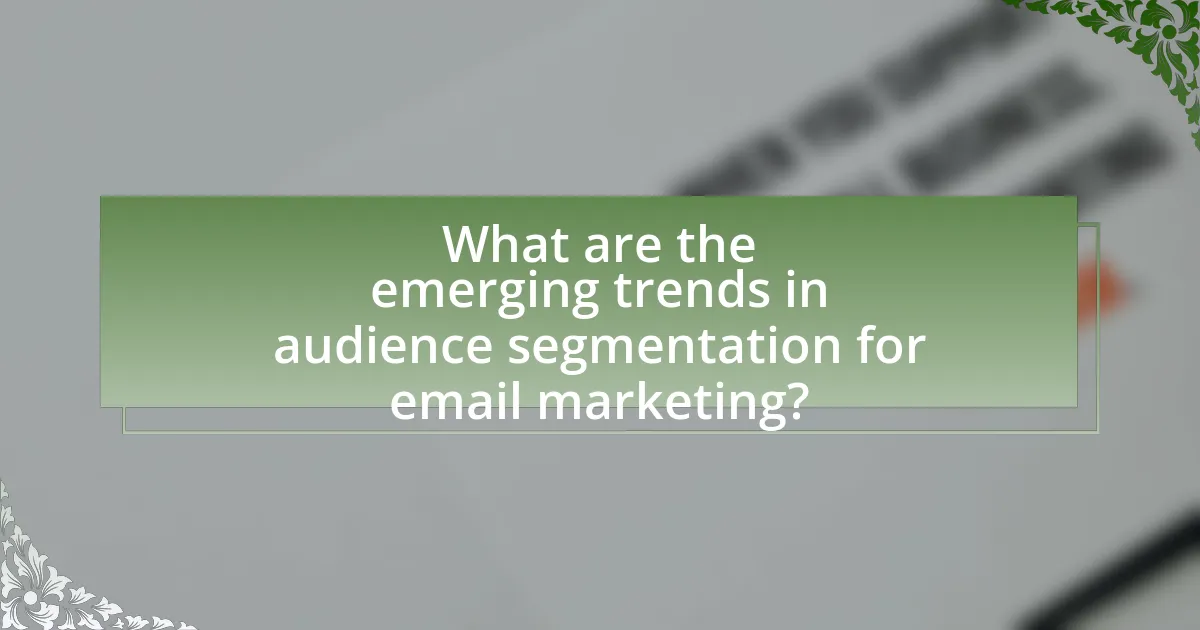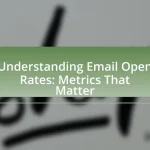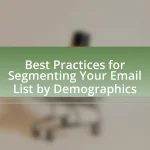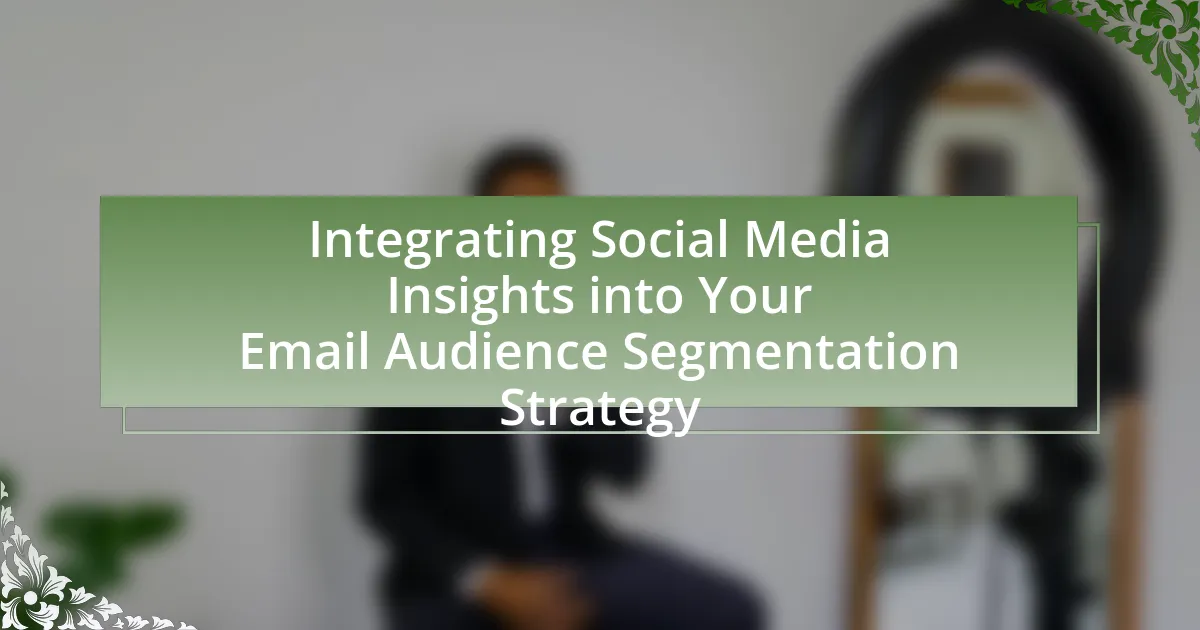The article focuses on the future of audience segmentation in email marketing, emphasizing the increasing reliance on advanced data analytics and artificial intelligence for creating hyper-personalized experiences. It outlines how segmentation is defined, its key elements, and its importance for enhancing engagement and conversion rates. The article also discusses emerging trends such as hyper-personalization and behavioral targeting, the role of machine learning and predictive analytics, and the benefits of using behavioral data for effective segmentation. Additionally, it provides practical tips for marketers to adapt their strategies, tools for effective segmentation, and best practices to avoid common mistakes.

What is the Future of Audience Segmentation in Email Marketing?
The future of audience segmentation in email marketing will increasingly rely on advanced data analytics and artificial intelligence to create hyper-personalized experiences. As businesses gather more granular data on consumer behavior, preferences, and engagement patterns, segmentation will evolve from broad categories to highly specific micro-segments. For instance, according to a report by McKinsey, companies that excel in personalization can achieve up to 10-15% higher revenue than their competitors. This trend indicates that marketers will prioritize real-time data processing and machine learning algorithms to dynamically adjust segments based on user interactions, leading to more relevant content delivery and improved customer retention rates.
How is audience segmentation defined in the context of email marketing?
Audience segmentation in the context of email marketing is defined as the process of dividing a target audience into distinct groups based on specific characteristics or behaviors. This approach allows marketers to tailor their email content and campaigns to meet the unique needs and preferences of each segment, thereby increasing engagement and conversion rates. Research indicates that segmented email campaigns can achieve a 14.31% higher open rate compared to non-segmented campaigns, demonstrating the effectiveness of this strategy in enhancing communication and driving results.
What are the key elements of effective audience segmentation?
The key elements of effective audience segmentation include demographic data, behavioral insights, psychographic factors, and geographic information. Demographic data, such as age, gender, and income, helps marketers understand the basic characteristics of their audience. Behavioral insights, including purchase history and engagement levels, allow for tailored messaging based on past interactions. Psychographic factors, which encompass interests, values, and lifestyles, provide deeper understanding of audience motivations. Geographic information, such as location and regional preferences, enables marketers to customize content relevant to specific areas. These elements collectively enhance targeting accuracy, leading to improved engagement and conversion rates in email marketing campaigns.
How does audience segmentation enhance email marketing strategies?
Audience segmentation enhances email marketing strategies by allowing marketers to tailor their messages to specific groups based on demographics, behaviors, and preferences. This targeted approach increases engagement rates, as segmented audiences are more likely to respond positively to content that resonates with their interests. For instance, a study by Mailchimp found that segmented campaigns can lead to a 14.31% higher open rate compared to non-segmented campaigns. By delivering personalized content, businesses can improve customer satisfaction and drive conversions, ultimately leading to higher return on investment (ROI) in their email marketing efforts.
Why is audience segmentation important for email marketing success?
Audience segmentation is crucial for email marketing success because it allows marketers to tailor their messages to specific groups, increasing engagement and conversion rates. By dividing an audience based on demographics, behaviors, or preferences, marketers can send relevant content that resonates with each segment. Research shows that segmented email campaigns can achieve up to 760% higher revenue than non-segmented campaigns, highlighting the effectiveness of this strategy in driving sales and customer loyalty.
What impact does audience segmentation have on engagement rates?
Audience segmentation significantly enhances engagement rates by allowing marketers to tailor content to specific groups based on demographics, behaviors, and preferences. This targeted approach leads to higher open and click-through rates; for instance, segmented email campaigns can achieve up to 14.31% higher open rates compared to non-segmented campaigns, according to a study by Mailchimp. By delivering relevant content to distinct audience segments, marketers can foster stronger connections and drive more meaningful interactions, ultimately improving overall engagement metrics.
How does segmentation influence conversion rates in email campaigns?
Segmentation significantly enhances conversion rates in email campaigns by allowing marketers to tailor content to specific audience groups. When emails are personalized based on demographics, behaviors, or preferences, recipients are more likely to engage with the content, leading to higher open and click-through rates. For instance, a study by Mailchimp found that segmented campaigns had an average open rate of 14.32%, compared to 11.4% for non-segmented campaigns, demonstrating a clear link between segmentation and improved engagement. This targeted approach not only increases the likelihood of conversions but also fosters customer loyalty, as recipients feel that the communication is relevant to their needs.

What are the emerging trends in audience segmentation for email marketing?
Emerging trends in audience segmentation for email marketing include hyper-personalization, behavioral targeting, and the use of artificial intelligence. Hyper-personalization leverages data analytics to create tailored content based on individual preferences, significantly increasing engagement rates. Behavioral targeting focuses on segmenting audiences based on their interactions with previous emails, allowing marketers to send relevant messages at optimal times. The integration of artificial intelligence enhances segmentation by analyzing vast amounts of data to predict customer behavior and preferences, leading to more effective campaigns. According to a study by McKinsey, companies that excel in personalization can generate 40% more revenue from those activities than average players.
How is artificial intelligence shaping audience segmentation?
Artificial intelligence is transforming audience segmentation by enabling more precise and dynamic categorization of consumers based on their behaviors and preferences. AI algorithms analyze vast amounts of data, including browsing history, purchase patterns, and social media interactions, to identify distinct audience segments with high accuracy. For instance, a study by McKinsey & Company found that companies using AI for customer segmentation can achieve up to 20% more revenue than those that do not. This data-driven approach allows marketers to tailor their email campaigns more effectively, ensuring that messages resonate with specific audience segments, ultimately enhancing engagement and conversion rates.
What role does machine learning play in refining segmentation strategies?
Machine learning enhances segmentation strategies by enabling more precise and dynamic audience targeting. It analyzes vast datasets to identify patterns and behaviors that traditional methods may overlook, allowing marketers to create highly tailored segments based on user preferences and interactions. For instance, a study by McKinsey & Company found that companies using advanced analytics, including machine learning, can improve their marketing ROI by 15-20%. This capability allows for real-time adjustments to segmentation, ensuring that marketing efforts remain relevant and effective as consumer behaviors evolve.
How can predictive analytics enhance audience targeting?
Predictive analytics enhances audience targeting by utilizing historical data and algorithms to forecast future behaviors and preferences of potential customers. This approach allows marketers to segment their audience more effectively, tailoring messages and campaigns to specific groups based on predicted interests and actions. For instance, a study by McKinsey & Company found that companies using predictive analytics in their marketing strategies can increase their marketing ROI by 15-20%. By analyzing patterns in customer data, businesses can identify high-value segments, optimize their outreach, and improve engagement rates, ultimately leading to higher conversion rates and customer satisfaction.
What are the benefits of using behavioral data for segmentation?
Using behavioral data for segmentation enhances marketing effectiveness by allowing for more personalized and targeted communication. This approach enables marketers to analyze customer actions, such as purchase history and engagement levels, leading to tailored messaging that resonates with specific audience segments. Research indicates that personalized emails can generate six times higher transaction rates compared to non-personalized ones, demonstrating the tangible benefits of leveraging behavioral insights for segmentation.
How does tracking user behavior improve segmentation accuracy?
Tracking user behavior enhances segmentation accuracy by providing detailed insights into individual preferences and interactions. This data allows marketers to categorize users based on specific actions, such as email opens, clicks, and website visits, leading to more tailored and relevant messaging. For instance, a study by HubSpot found that personalized emails based on user behavior can increase click-through rates by 14% and conversion rates by 10%. By analyzing these behaviors, marketers can create more precise segments, ensuring that content resonates with the target audience, ultimately improving engagement and effectiveness in email marketing campaigns.
What types of behavioral data are most effective for email marketing?
The most effective types of behavioral data for email marketing include engagement metrics, purchase history, and browsing behavior. Engagement metrics, such as open rates and click-through rates, provide insights into how recipients interact with emails, allowing marketers to tailor content accordingly. Purchase history reveals customer preferences and can inform personalized product recommendations, enhancing the likelihood of repeat purchases. Browsing behavior, including pages visited and time spent on site, helps marketers understand customer interests and can be used to create targeted campaigns that resonate with specific segments. These data types collectively enable marketers to optimize their email strategies, leading to improved customer engagement and conversion rates.

How can marketers adapt to the future of audience segmentation?
Marketers can adapt to the future of audience segmentation by leveraging advanced data analytics and artificial intelligence to create more personalized and dynamic audience profiles. This approach allows marketers to analyze vast amounts of consumer data, including behavioral patterns and preferences, enabling them to segment audiences more accurately and effectively. For instance, a study by McKinsey & Company found that companies using advanced analytics for segmentation can achieve a 10-20% increase in marketing effectiveness. By continuously updating these profiles in real-time, marketers can respond to changing consumer behaviors and preferences, ensuring that their messaging remains relevant and engaging.
What strategies should marketers implement to stay ahead in segmentation?
Marketers should implement data-driven personalization and advanced analytics to stay ahead in segmentation. By leveraging customer data and behavioral insights, marketers can create highly targeted campaigns that resonate with specific audience segments. For instance, according to a study by Epsilon, 80% of consumers are more likely to make a purchase when brands offer personalized experiences. Additionally, utilizing machine learning algorithms can enhance segmentation accuracy by identifying emerging trends and patterns in consumer behavior, allowing marketers to adapt their strategies in real-time. This approach not only improves engagement rates but also drives higher conversion rates, making it essential for marketers to prioritize these strategies in their segmentation efforts.
How can marketers leverage data privacy regulations in their segmentation efforts?
Marketers can leverage data privacy regulations in their segmentation efforts by ensuring compliance while enhancing consumer trust and engagement. By adhering to regulations such as GDPR and CCPA, marketers can collect and utilize data in a transparent manner, which fosters a positive relationship with consumers. This compliance allows marketers to segment their audience based on explicit consent and preferences, leading to more targeted and relevant messaging. Research indicates that 81% of consumers feel a lack of control over their data, and by respecting privacy regulations, marketers can address these concerns, ultimately improving segmentation accuracy and effectiveness.
What tools are available for effective audience segmentation?
Effective audience segmentation can be achieved using tools such as HubSpot, Mailchimp, and Segment. HubSpot offers advanced analytics and CRM capabilities that allow marketers to categorize audiences based on behavior and demographics. Mailchimp provides customizable segmentation options based on user engagement and purchase history, enabling targeted email campaigns. Segment specializes in data integration, allowing businesses to collect and analyze customer data from multiple sources to create detailed audience profiles. These tools are widely recognized in the marketing industry for their effectiveness in enhancing audience targeting and improving campaign performance.
What best practices should be followed for effective audience segmentation?
Effective audience segmentation requires the use of data-driven criteria to categorize audiences based on shared characteristics. Best practices include utilizing demographic data, such as age, gender, and location, alongside psychographic factors like interests and behaviors. Research indicates that personalized marketing campaigns can increase engagement rates by up to 29%, demonstrating the effectiveness of targeted messaging. Additionally, leveraging behavioral data, such as past purchase history and email interaction, allows marketers to refine their segmentation further, leading to improved conversion rates. Regularly updating segmentation criteria based on evolving customer data ensures that marketing efforts remain relevant and effective.
How often should audience segments be updated and refined?
Audience segments should be updated and refined at least quarterly. Regular updates are essential to account for changes in consumer behavior, preferences, and market trends. Research indicates that businesses that frequently refine their audience segments can achieve up to a 20% increase in engagement rates, as they are better aligned with the current interests and needs of their target audience.
What common mistakes should marketers avoid in audience segmentation?
Marketers should avoid several common mistakes in audience segmentation, including relying on outdated data, oversimplifying segments, and neglecting behavioral insights. Relying on outdated data can lead to misaligned strategies, as audience preferences and behaviors evolve over time. Oversimplifying segments, such as grouping all customers by a single demographic factor, ignores the complexity of consumer behavior and can result in ineffective targeting. Neglecting behavioral insights, such as past purchase history or engagement levels, prevents marketers from creating personalized experiences that resonate with their audience. These mistakes can hinder the effectiveness of email marketing campaigns and reduce overall engagement rates.
What practical tips can enhance audience segmentation in email marketing?
To enhance audience segmentation in email marketing, utilize data analytics to identify customer behaviors and preferences. By analyzing metrics such as purchase history, engagement rates, and demographic information, marketers can create targeted segments that reflect the specific interests and needs of their audience. For instance, a study by Mailchimp found that segmented campaigns can lead to a 14.31% higher open rate compared to non-segmented campaigns, demonstrating the effectiveness of tailored messaging. Additionally, employing A/B testing on different segments allows marketers to refine their strategies based on real-time feedback, further optimizing engagement and conversion rates.




